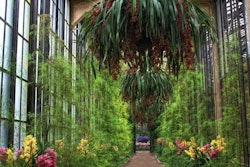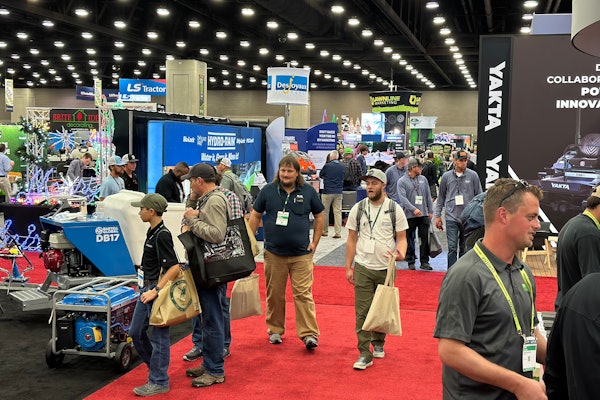 Users explore their surroundings while using virtual reality viewers.
Users explore their surroundings while using virtual reality viewers.Photo: Belgard
Virtual reality (VR) has always been an element of stories set in the future, but now that the capability is actually here there is a lot of untapped potential for landscapers.
At first regarded as a novelty, the technology began to become more accessible and useful around 2014 with the emergence of the viewers such as Google Cardboard, which allowed users to cheaply and easily turn their phone into a VR headset.
Since VR has grown in popularity, landscape companies have started to include it in their pitches like Urban Ecosystems.
Joe Raboine, director of Belgard’s Design Studio, has noticed that VR is particular great for showcasing hardscaping projects, namely outdoor living spaces, due to their complexity.
“It definitely helps people understand the space better,” he says.
Currently one of the major barriers preventing VR from overtaking 3D renderings entirely is the fact that because so many apps can be used as a viewer, the level of quality cannot be controlled.
“The quality of the cellphone is what really makes the difference,” Raboine says. “The refresh rate will be worse on an older phone than say an iPhone 7. In the next couple of years for sure contractors will have phones like these.”
This doesn’t mean that animations and 3D renders no longer have their uses, as Raboine advises to still include them in presentations. VR is simply another level to increase the immersive nature of the project.
“There’s something about standing in the space,” Raboine says. “When they feel like they’re in their backyard and they can look up at the sky and look down at the pavers, we think that’s what leads to the high closing rate. There’s an emotional connection.”
The detail of VR versus 3D rendering is very similar, according to Raboine. They can create higher quality images for the VR in the case of a large project where they want to do something impressive, but this does increase the rendering time.
“It will be an hour and a half longer compared to a few minutes for a really negligible difference,” he says.
Belgard doesn’t currently give the user the option to change materials or move things around while viewing things in virtual reality, and it generally offers five or six views the user can jump between. But Raboine predicts the next generation of VR will make this interactive feature far more accessible to landscape contractors.
“There’s a lot more that goes into being able to change things on the fly; that’s the next generation,” he says.
Truly interactive VR calls for technology such as Oculus Rift and different software and equipment that is far more expensive.
When it comes down to the drawbacks of using VR with customers, Raboine only lists one: nausea.
“Some people aren’t particularly excited about putting the viewer on,” he says. “Motion sickness is the number one drawback. Some can only be in there a couple of minutes.”
Contrary to popular belief, creating a project for virtual reality doesn’t require any special expertise, one only needs to have software that has a VR export option. However, the software that Belgard is using is very expensive.
“To do what we’re doing is an $8,000 to $10,000 investment, and then you have to learn the software,” he says. “We try to let them (landscape contractors) focus on being creative and selling and installing products, but we’re also willing to work with them and help them use the software.”
As for the future, Raboine expects that VR will indeed replace 3D rendering, but this won’t occur for another three to five years.
“What may even leapfrog and replace VR is augmented reality,” he says. “We’re working both tracks. In another five years, virtual and augmented reality are going to be incredible, getting cheaper and faster.”
Augmented reality would allow the landscape designer to save time by not having to build out the environment, but instead superimpose the render over the reality. As of right now it doesn’t work very well in outdoor settings due to the sunlight, but Raboine believes as technology improves it will give VR a run for its money.
“Overall, it’s super exciting,” he says. “I used to hand sketch everything and now this technology is here and customers are just blown away by it. It makes them excited about the project instead of scared of it.”









